Types of Night Vision Devices.
- Night Vision Goggles
- Night Vision Scopes
- Night Vision Binoculars
- Night Vision CCTV Cameras
- Night Vision Driving Glasses
Night vision devices are made to help see in low light or completely dark conditions. They make it possible for images to be produced in levels of light approaching complete darkness.
These devices are necessary and come in handy when observing wildlife, night fishing and boating, night hunting and paintball, camping, search and rescue, detecting hidden objects, and performing nighttime repairs.
The devices commonly have a customized optical tube for imaging infrared light and an integrated infrared sensor that converts invisible infrared light into visible light that can be seen and analyzed by the human eye.
Let’s have a look at various types of night vision devices
Types of Night Vision Devices
1. Night Vision Goggles
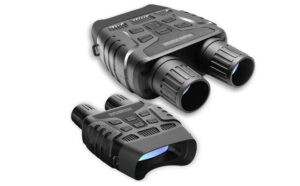
Night Vision goggles are electronic devices that let the user see better in the dark. They provide a hands-free alternative to other night vision equipment. Generally, there are two types of night vision goggles (image intensification and thermal imaging). They both allow you to see in the dark but in an entirely different way.
Night vision goggles are ideal for all situations where you need to spend a long time watching.
Check out the Best Night Vision Goggles on
Factors to Consider when Choosing the Best Night Vision Goggles
- Resolution
The resolution characterizes the ability of the device to display two close points or lines separately. The resolution is usually provided in dashes per millimeter.
The higher the resolution in the dashes per millimeter and the lower the angular value, the higher the resolution. A higher resolution ensures a clearer image for the wearer.
- Spectrum
The device increases the brightness of the object thousands of times. This can either be natural light or IR illumination that is converted into a visible spectrum.
The UV range extends from 100 to 400 nm while the near-ultraviolet range extends to the lower limit from 300 to 400nm. The visible part of the spectrum has the capability to extend ominously from 400 to 750 nm.
- Magnification and Field of View
Night vision goggles lack the capability of magnifying n image. This is however not always a drawback. Magnification of 1x offers the widest field of view possible which is paramount in many cases.
- Batteries
These devices require their own source of electrical energy which is batteries. Longer battery life means that you change the batteries less often and the googles are less likely to fail because of a failing power source.
- Size and weight
Night vision goggles are expedient to use as they are lightweight and have a convenient size. They have to be worn on your head always. Wearers may feel uncomfortable because of the excessive weight of the device.
It is thus important to pay special attention to the device’s weight. The helmet or skull crusher with the mobile monocular attachment should also fit the size of each head or helmet.
2. Night Vision Scopes
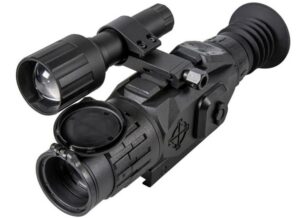
Night Vision Scopes are the ultimate tools for hunters when it comes to shooting. They use an image intensifier tube to amplify photons of light so as to provide a clear picture for the shooter even in the darkest conditions.
They are used to intensify human sight in conditions with low light. There are different types of night vision scopes. First, there are infrared imaging systems which are also known as active night visions scopes and focus infrared light on a scene.
Image converting technology transforms the scene illuminated by the infrared into a visible image.
Thermal imaging systems work in the same manner, converting the pattern of heat released by objects, people, or animals into a visual image.
Passive night vision scopes on the other hand amplify images picked up in less light. The view through a passive night vision device may be from 20,000 to 50,000 times brighter than what the naked eye could see.
Check out the Best Night Vision Scopes on
Factors to Consider when selecting Night Vision Scopes
- Magnification
The magnification of night vision scopes generally goes up to 10x. The greater the magnification, the bigger the scope is. Bigger however doesn’t always mean better.
Night vision scopes with 5x magnification are the most sought-after choice for most hunters. There are also those without magnification but are reserved for close-range shooting and general use.
- Size and weight
Night vision scopes are larger heavier than conventional scopes. You want a lighter scope as a heavy one for a long time means fatigue. The size and weight may however not be a big deal if you are camping for a specific spot instead of walking around looking for game.
- Batteries
This is another important factor to put in mind. How long the battery lasts is of the essence. Also, see whether you can find a scope that uses rechargeable batteries for better value.
- Field of view
The field of view shows how wide you can see at a specific distance. The field of view decreases as the magnification increases. With that said, you usually scan at lower magnifications for movement then zoom in to confirm what the movement is.
3. Night Vision Binoculars
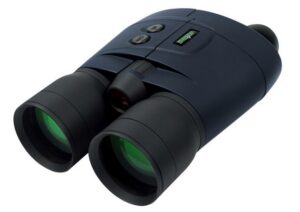
Night Vision Binoculars come in handy when you are trying to assess your environment in low light or dark conditions. These devices allow you to see clearly in ambient or dark conditions.
They use infrared or thermal imaging technology to improve every object that you see. Additionally, they enable you to see at a distance and identify targets with better clarity.
They are essential for people who enjoy outdoor activities after dark. They come in various types such as Generation 1, 2, 3, and 4, and all have various purposes.
Check out the Best Night Vision Binoculars on
Generation 1
Generation 1 night vision binoculars are considered ideal for consistent use. These models are normally the most affordable and common. They are best suited for observing wildlife. They provide a decent image at closer ranges but tend to be limited by lower resolutions and a limited overall visual range of about 75 yards.
Generation 2
Generation 2 night vision binoculars are very functional hence popular. They have better clarity thus perfect for professional use. They also include a microchannel plate that provides a clearer and brighter image along with better visual ranges around 200 yards.
Generation 3
These binoculars offer a better picture, execute better in low light and have better battery life. They are considered tactical or military-grade and are the best picks for long-range viewing at distances around 300 yards.
Generation 4
Generation 4 night vision binoculars are the ultimate choice and are reserved for very serious users. They are the most expensive and provide the clearest picture. They outperform the other generations in low light conditions.
Factors to Consider when Buying Night Vision Binoculars
- Image quality
This is a very important consideration to put in mind when purchasing night vision binoculars. If you intend to carry out tactical missions or hunt for elusive prey, you want images that are sharp and clear. Look for binoculars with very high resolution for great results.
- Magnification and Field of view
You need a pair of night vision binoculars with high magnification so as see objects at great distances clearly. Field of view is the total viewing range in front of you when looking through the binoculars. Remember that the field of view decreases as the magnification increases.
- Detection range
The detection range is directly reliant on how and where you intend to use your night vision binoculars. Keep in mind that some binocular generations are more limited in their detection range than others.
- Purpose
Consider the activities that you plan to use the binoculars for so as to find the most appropriate model for your needs. Some want the device for viewing wildlife while others want one for nighttime hunting.
- Weather resistance
Finding a model that is waterproof or with a water-resistant rating is paramount especially if you intend to use it primarily outside. This ensures more durability hence lasts longer so that you don’t have to replace the pair often.
4. Night Vision CCTV Cameras
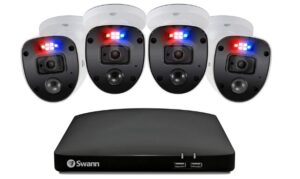
Many people depend on CCTV cameras for the physical protection of their families and businesses as well. Night vision CCTV cameras are popular as they guarantee a certain level of protection throughout. There are different types and configurations of CCTV cameras.
Check out the Best Night Vision CCTV Cameras on
Considerations when Buying Night Vision CCTV Cameras
- Color or Monochrome
Many color security cameras come with an Infrared filter that provides integrated night vision. The resolution of a black and white CCTV camera will usually be better than that of one color for a similar price.
Many night vision CCTV cameras use Infrared light, invisible to the human eye to flood the dark area with light hence capturing photos or videos. A CCTV camera with Infrared night vision helps keep the IR lights off when it detects adequate normal light in the surroundings and turns on when it gets dark.
- Installation area
It is crucial to consider the actual spot of the CCTV camera installation. It should be able to brave the weather and capture clear photos and videos if it is to be installed outside, near the driveway, fence line, or entrance.
A tough camera with a design to protect the actual lens from rain, debris, snow will work the best. You can use a different camera for indoor installation as it will not be exposed to harsh weather conditions.
- Lux rating
Lux rating basically refers to the ability of the camera to capture an image in different lighting conditions. Lower Lux ratings are preferable for a night vision CCTV camera as the camera will be able to capture clear images in low light or dark conditions
- Wireless or wired
A wired HD CCTV camera is ideal for expansive locations and spots as long as it can be wired. The wires and the camera may be easily visible to intruders who may deter them or let them evade their field of view.
Wireless camera systems are easy to install in spots that are hard to reach. They just need a clear line of sight between the receiver and transmitter. Wireless CCTV cameras are easier to conceal than their wide counterparts.
5. Night Vision Driving Glasses
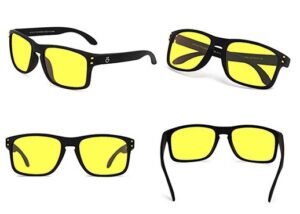
The traffic lights, street lamps, and headlights can put a strain on the yes and momentarily blind you at times. This is the last thing that you would want as you drive in low light or dark conditions.
Night vision driving glasses is what you need so that you feel confident and so that you see better and drive safer.
They are basically non-prescription glasses with yellow-tinted lenses and often include some kind of anti-reflective coating. They help minimize the glare from the lights and can offer a meaningful difference in your vision.
Factors to consider when buying Night Vision Driving Glasses
- Nose pads
Having a pair of glasses with comfortable nose pads is a must. Pads should be soft and pleasant on your face rather than rough and uncomfortable.
Plastic pads may put pressure on your nose and cause headaches and bruises on your skin. Rubber pads on the other hand are softer and tenderer on the skin and ensure you don’t fidget with the glasses.
- Lenses
Lenses are an important part of the glasses as they bring your view into focus. Polarized lenses help reduce glare from headlights, reflected surfaces, and harsh blue light.
Polycarbonate lenses are more impact-resistant and are perfect for anyone who is more physically active.
Progressive lenses enable the wearer to see more clearly whether it’s closer or farther away. Prescription glasses are made for those whose eyesight isn’t at its peak.
Protective coatings can also be installed on the glasses so as to fit your needs. The coatings can be anti-reflective and reduce eye strain from glare and reflections.
- Flexible arms
The arms of glasses wrap around your eyes to hold them in place. They should fit comfortably so that you avoid adjusting them constantly. Ones that are too short may slide off your face while those that are too long may not fit firmly on the ears.
- Styles
Night vision glasses come in various styles and colors. You will certainly find a pair that suits you.
See also: Best night vision driving glasses
Final Thoughts
Night vision devices are a must-have when you want to enhance vision in low light or dark conditions. They are helpful and greatly enhance your outdoor activities at night.
See Also
